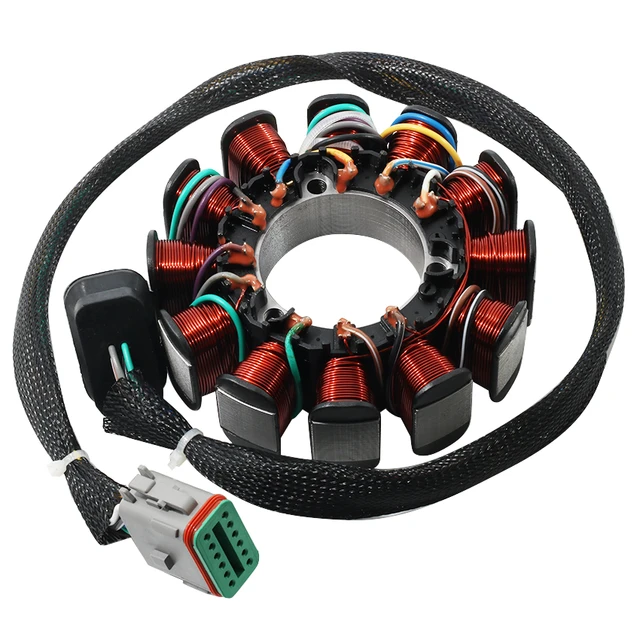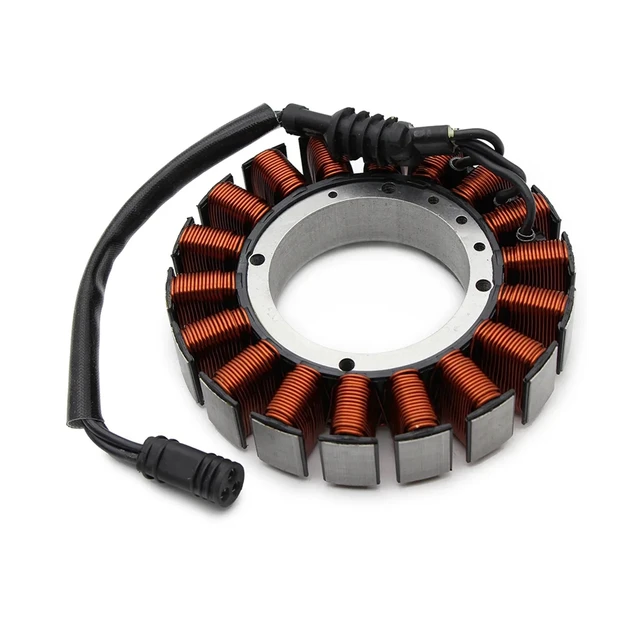The stator plays a critical role in your motorcycle’s electrical system, converting mechanical energy from the engine into electrical energy. This process powers the bike’s electrical components and charges the battery. If your motorcycle is experiencing electrical issues, a faulty stator could be the culprit. Knowing how to test motorcycle stator can save you time, money, and headaches. This comprehensive guide will explain the steps to effectively diagnose your stator, ensuring your motorcycle runs smoothly and reliably.
Understanding the Stator’s Function
Before diving into the testing process, it’s important to understand the basic function of the stator within your motorcycle’s electrical system. The stator is a stationary part of the alternator that contains coils of wire. When the motorcycle’s engine runs, a rotating magnet (known as the rotor) spins around the stator. This interaction generates alternating current (AC) electricity.
The stator typically works in conjunction with the regulator/rectifier, which converts AC electricity into direct current (DC) to charge the battery and power electrical components. If the stator fails, it can lead to a dead battery, malfunctioning lights, or other electrical problems, making it crucial to test this component when troubleshooting electrical issues.
Gathering Necessary Tools
To effectively test the stator, you’ll need a few specific tools. These tools are essential for accurate diagnostics and ensure you don’t overlook any potential issues.
- Multimeter: A digital multimeter is crucial for measuring voltage, resistance, and continuity. Ensure it’s in good working condition and the leads are intact.
- Service Manual: Your motorcycle’s service manual will provide specific details and specifications related to the stator testing. It’s an invaluable resource for accurate diagnostics.
- Screwdrivers and Wrenches: Basic hand tools will be necessary to access the stator and related components.
Having these tools on hand and ready to use will streamline the testing process and help you achieve precise results.
Initial Safety Precautions
Safety should always be a priority when working on your motorcycle’s electrical system. Taking the following precautions helps prevent accidents or damage during the testing process.
- Disconnect the Battery: Before you begin, disconnect the negative terminal of the battery to prevent any accidental short circuits.
- Work in a Well-Ventilated Area: If your testing involves running the engine, ensure you’re in a well-ventilated area to avoid inhaling exhaust fumes.
- Wear Protective Gear: Safety glasses and gloves can protect you from potential hazards like sparks or hot components.
Following these safety measures ensures a safer and more effective diagnostics process.
Visual Inspection
Start by conducting a thorough visual inspection of the stator and its surrounding components. Sometimes, visible signs of damage can immediately indicate a problem.
- Check for Physical Damage: Look for any signs of burnt wiring, frayed insulation, or corrosion on the stator. These are common indications of a faulty stator.
- Inspect Connectors and Terminals: Examine the connectors and terminals for loose connections, corrosion, or damage. These issues can affect the electrical performance and should be addressed before further testing.
A visual inspection, while simple, can provide critical insights and guide your testing process.
Testing for Continuity
One of the initial tests involves checking for continuity within the stator coils. This test checks if the coils are intact and connected properly.
- Set the Multimeter: Turn your multimeter to the continuity setting, usually indicated by a diode symbol or sound wave symbol.
- Test Between Leads: Touch the multimeter leads to the stator’s output wires, typically labeled as A, B, and C. Check for continuity between each pair (A-B, B-C, and A-C). The multimeter should beep or show 0 ohms if the coils are intact.
- Check for Ground: Also, test each output wire to the stator’s metal body. There should be no continuity. If there is, it indicates a short to ground within the stator.
This continuity test helps you determine if the stator windings are in good condition or if there are breaks or shorts.
Measuring Resistance
Another crucial test is measuring the resistance of the stator coils. Each stator type has a specific resistance value range that can be found in the service manual.
- Set the Multimeter to Ohms: Switch your multimeter to the ohms (Ω) setting.
- Measure Each Pair: Measure the resistance between each pair of stator wires (A-B, B-C, and A-C). Compare the readings to the specifications in your service manual.
- Consistent Readings: The resistance values should be consistent with the manual’s specifications. Significantly higher or lower readings indicate a potential problem with the stator windings.
Measuring resistance helps identify potential issues within the stator coils, ensuring they’re operating within the specified range.
Checking AC Output Voltage
Testing the AC output voltage requires the engine to be running, so take necessary precautions to conduct this safely. This test measures the amount of AC voltage produced by the stator at different RPM levels.
- Set the Multimeter to AC Voltage: Adjust the multimeter to measure AC voltage (V~).
- Access Stator Output Wires: Locate the stator connectors and keep them accessible without making direct contact with any moving parts.
- Start the Engine: Start your motorcycle and rev the engine to approximately 2000-3000 RPM.
- Measure Voltage: Measure the AC voltage between each pair of stator wires (A-B, B-C, and A-C). Compare the readings to your service manual specifications. Typically, you should see increasing voltage as the engine RPM increases.
Accurate AC voltage readings indicate that the stator is generating the necessary electricity to power the motorcycle’s electrical systems.
Interpreting Results and Next Steps
Once you’ve completed these tests, interpreting the results accurately is essential. Here’s what different outcomes might suggest.
- Normal Results: If all readings (continuity, resistance, and AC voltage) fall within the specified range, your stator is likely in good working condition.
- Abnormal Continuity or Resistance: If you detect continuity where there shouldn’t be any, or if resistance readings are outside the acceptable range, it indicates a problem within the stator windings. This typically necessitates stator replacement.
- Low AC Voltage: If the AC output voltage is below the specified range, especially at higher RPMs, it suggests that the stator is not generating adequate electricity, likely due to damaged or degraded coils.
Based on your findings, you can decide whether repairs or replacements are needed. Always refer to your service manual for precise specifications and guidance throughout this process.
Reassembling and Final Checks
After testing, it’s time to reassemble any components you disassembled during the process. Ensure everything is put back correctly to avoid future problems.
- Reconnect Wires and Connectors: Ensure all connections are secure and free of corrosion or damage.
- Reattach Battery: Reconnect the negative terminal of the battery.
- Final Visual Inspection: Perform one last visual inspection to confirm that everything is in place correctly.
Once reassembled, start your motorcycle and check for any electrical issues. If problems persist, consider seeking professional assistance for more in-depth diagnostics and repairs.
 Consider Professional Help
Consider Professional Help
If diagnosing and fixing the stator issue feels overwhelming, don’t hesitate to seek professional help. Experienced motorcycle mechanics have the tools and expertise to accurately diagnose and repair electrical system issues.
- Professional Diagnostics: Certified mechanics have access to specialized diagnostic tools that can pinpoint issues more accurately than basic testing methods.
- Guaranteed Repairs: Professional repairs often come with warranties, ensuring peace of mind knowing that the job has been done right.
Leveraging professional expertise can save you time and prevent the risk of incorrect diagnosis or repair attempts.
Routine Maintenance Tips
To extend the life of your stator and ensure your motorcycle’s electrical system remains in top condition, practice routine maintenance.
- Regular Inspections: Periodically check the stator and electrical connections for signs of wear, corrosion, or damage.
- Clean Connections: Ensure all connectors and terminals are clean and secure. Use a commercial electrical contact cleaner if necessary.
- Monitor Battery Health: A healthy battery reduces the load on the stator. Regularly check and maintain your motorcycle battery.
Routine maintenance helps catch potential issues early, preventing more extensive (and expensive) repairs down the line.
Conclusion
So, how do you test motorcycle stator effectively? The process involves gathering the right tools, following safety precautions, conducting a visual inspection, testing for continuity and resistance, measuring AC output voltage, and interpreting the results. By reassembling components properly and performing final checks, you can ensure a thorough and accurate diagnosis. If necessary, seek professional help to confirm your findings and carry out any required repairs. Consistent routine maintenance will also help keep your stator and the entire electrical system in optimal condition, ensuring reliable and safe motorcycle performance. Embrace these steps and keep your motorcycle running smoothly and efficiently for every ride.












